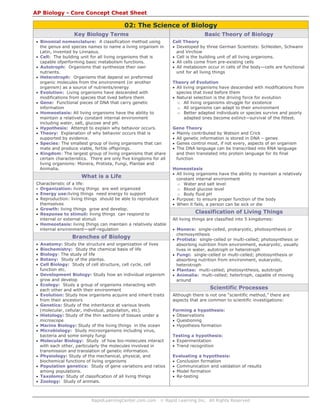Weitere ähnliche Inhalte
Ähnlich wie Science of Biology Cheat sheet (20)
Mehr von Timothy Welsh (20)
Kürzlich hochgeladen (20)
Science of Biology Cheat sheet
- 1. RapidLearningCenter.com.com © Rapid Learning Inc. All Rights Reserved
AP Biology - Core Concept Cheat Sheet
02: The Science of Biology
Key Biology Terms
• Binomial nomenclature: A classification method using
the genus and species names to name a living organism in
Latin, invented by Linnaeus.
• Cell: The building unit for all living organisms that is
capable ofperforming basic metabolism functions.
• Autotroph: Organisms that synthesize their own
nutrients.
• Heterotroph: Organisms that depend on preformed
organic molecules from the environment (or another
organism) as a source of nutrients/energy
• Evolution: Living organisms have descended with
modifications from species that lived before them
• Gene: Functional pieces of DNA that carry genetic
information
• Homeostasis: All living organisms have the ability to
maintain a relatively constant internal environment
including water, salt, glucose and pH.
• Hypothesis: Attempt to explain why behavior occurs.
• Theory: Explanation of why behavior occurs that is
supported by evidence.
• Species: The smallest group of living organisms that can
mate and produce viable, fertile offsprings.
• Kingdom: The largest group of living organisms that share
certain characteristics. There are only five kingdoms for all
living organisms: Monera, Protista, Fungi, Plantae and
Animalia.
What is a Life
Characteristic of a life:
• Organization: living things are well organized
• Energy use:living things need energy to support
• Reproduction: living things should be able to reproduce
themselves
• Growth: living things grow and develop.
• Response to stimuli: living things can respond to
internal or external stimuli
• Homeostasis: living things can maintain a relatively stable
internal environment—self-regulation
Branches of Biology
• Anatomy: Study the structure and organization of lives
• Biochemistry: Study the chemical basis of life
• Biology: The study of life
• Botany: Study of the plantss.
• Cell Biology: Study of cell structure, cell cycle, cell
function etc.
• Development Biology: Study how an individual organism
grow and develop
• Ecology: Study a group of organisms interacting with
each other and with their environment
• Evolution: Study how organisms acquire and inherit traits
from their ancestors
• Genetics: Study of the inheritance at various levels
(molecular, cellular, individual, population, etc).
• Histology: Study of the thin sections of tissues under a
microscope
• Marine Biology: Study of the living things in the ocean
• Microbiology: Study microorganisms including virus,
bacteria and some simply fungi
• Molecular Biology: Study of how bio-molecules interact
with each other, particularly the molecules involved in
transmission and translation of genetic information.
• Physiology: Study of the mechanical, physical, and
biochemical functions of living organisms
• Population genetics: Study of gene variations and ratios
among populations.
• Taxolomy: Study of classification of all living things
• Zoology: Study of animals.
Basic Theory of Biology
Cell Theory
• Developed by three German Scientists: Schleiden, Schwann
and Virchow
• Cell is the building unit of all living organisms.
• All cells come from pre-existing cells
• All metaboism occur in cells of the body—cells are functional
unit for all living things
Theory of Evolution
• All living organisms have descended with modifications from
species that lived before them
• Natural selection is the driving force for evolution
o All living organisms struggle for existence
o All organisms can adapt to their environment
o Better adapted individuals or species survive and poorly
adapted ones become extinct—survival of the fittest.
Gene Theory
• Mainly contributed by Watson and Crick
• All genetic information is stored in DNA – genes
• Genes control most, if not every, aspects of an organism
• The DNA language can be transcribed into RNA language
and then translated into protein language for its final
function
Homeostasis
• All living organisms have the ability to maintain a relatively
constant internal environment
o Water and salt level
o Blood glucose level
o Body fluid pH
• Purpose: to ensure proper function of the body
• When it fails, a person can be sick or die
Classification of Living Things
All living things are classified into 5 kingdomes:
• Monera: single-celled, prokaryotic, photosynthesis or
chemosynthesis
• Protista: single-celled or multi-celled; photosynthesis or
absorbing nutrition from environment, eukaryotic, usually
lives in water, autotroph or heterotroph
• Fungi: single-celled or multi-celled; photosynthesis or
absorbing nutrition from environment, eukaryotic,
heterotroph
• Plantae: multi-celled; photosynthesis, autotroph
• Animalia: multi-celled; hetertroph, capable of moving
around
Scientific Processes
Although there is not one “scientific method,” there are
aspects that are common to scientific investigations:
Forming a hypothesis:
• Observations
• Questioning
• Hypothesis formation
Testing a hypothesis:
• Experimentation
• Trend recognition
Evaluating a hypothesis:
• Conclusion formation
• Communication and validation of results
• Model formation
• Re-testing

